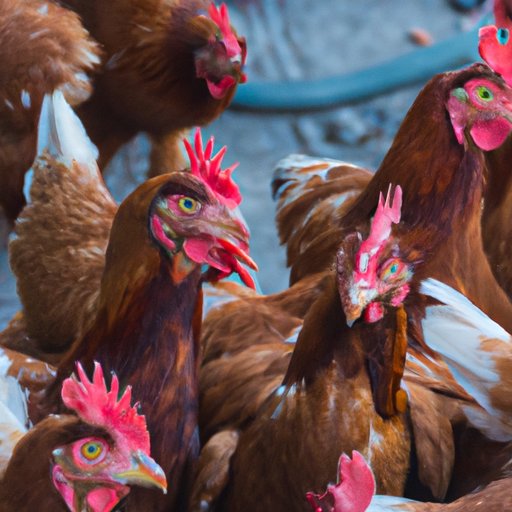Why Is Chicken So Expensive?
Chicken, once considered a cheap source of protein, has now become an expensive commodity. The price of chicken has been rising steadily over the years, causing consumers to wonder – why is chicken so expensive? In this article, we’ll investigate the various factors responsible for the rise in chicken prices.
Investigating the Rise in Feed Costs
Feed costs account for a significant portion of the total cost of chicken production. The cost of chicken feed has been steadily rising over the years, due to a variety of factors such as droughts, floods, and other weather-related events that can impact the supply and demand of crops. Farmers have little control over the cost of feed and must absorb the cost increases themselves.
In addition to weather-related events, the popularity of biofuels has also contributed to rising feed costs. The use of corn and soybeans for biofuel production has increased the demand for these crops, driving up their prices. This, in turn, has impacted the price of chicken feed, since both corn and soybeans are commonly used in chicken feed formulations.
So how do fluctuations in feed costs affect chicken prices? As the cost of feed increases, the cost of producing chicken also increases. This cost is passed on to the consumer, resulting in higher chicken prices at the store. To mitigate the impact of feed costs, some farmers are moving towards more sustainable and cost-effective feed options, such as insects and algae.
Exploring the Role of Labor Costs
Labor costs are another factor contributing to the rise in chicken prices. The labor required for chicken production is intense, from the initial stages of caring for the chicks to the final processing before the chickens reach the market. Labor shortages and labor laws also impact the cost of chicken production.
During the COVID-19 pandemic, many chicken processing plants faced shutdowns and restrictions due to worker safety concerns. This resulted in a drop in chicken production and, subsequently, higher prices at the grocery store. In addition, labor laws that mandate higher wages and benefits for workers also add to the overall cost of chicken production.
Possible solutions to address labor cost issues include investing in automation and robotics to reduce the reliance on human labor and increasing worker protections and benefits to address worker shortages.
Examining Supply Chain Disruptions
The COVID-19 pandemic has also caused supply chain disruptions that have impacted the price of chicken. The shutdowns and restrictions on processing plants have caused a decrease in the supply of chicken, resulting in higher prices. In addition, transportation disruptions, closures of restaurants and foodservice establishments, and panic-buying by consumers have all contributed to fluctuations in chicken prices.
To mitigate the impact of supply chain disruptions, producers and distributors are implementing strategies such as increasing the buffer stocks of essential supplies, enhancing communication and coordination within the supply chain, and finding alternative routes for transportation.
Comparing Chicken Prices to Other Meats
Chicken has long been considered a more affordable meat option in comparison to beef or lamb. However, in recent years, the cost of chicken has increased substantially, making it less of a budget-friendly option.
Data comparing chicken prices to other animal proteins indicate that chicken prices have risen at a faster rate than beef or pork prices. One reason for this could be the increasing demand for chicken, both domestically and internationally, which puts pressure on the supply and contributes to higher prices.
Another reason for the rise in chicken prices is the overall cost of chicken production, which includes feed costs, labor costs, and other factors. These costs have risen over time, causing chicken prices to increase.
Discussing Animal Welfare Regulations
Animal welfare regulations are another factor that contributes to the rising price of chicken. Governments around the world have implemented regulations to ensure the humane treatment of chickens during their lifecycle. These regulations require better living conditions, more space, and higher-quality feed for chickens. All of these factors contribute to increased costs for producers, which are eventually passed on to the consumer.
As consumers become more aware of the impact of animal welfare on chicken production, they are demanding higher welfare chicken products. This increase in demand for higher welfare chicken further adds to the overall cost of chicken production and, subsequently, the price of chicken products.
Analyzing International Trade Policies
The complex international trade policies affecting chicken prices include tariffs and trade agreements. Tariffs on imported chicken products can increase the cost of these products, making domestically produced chicken more competitive. However, trade agreements that allow for the import of cheaper chicken products can negatively impact domestic chicken producers by flooding the market with cheaper products and reducing demand for domestically produced chicken.
Overall, international trade policies can have a significant impact on the price of chicken, as well as on the overall competitiveness of domestic chicken producers.
Conclusion
The rise in chicken prices is due to a variety of factors, including rising feed costs, labor costs, supply chain disruptions, animal welfare regulations, and international trade policies. While some of these factors are outside of consumers’ control, knowing what contributes to the cost of chicken can help them make informed purchasing decisions. Possible solutions to address rising chicken prices include investing in sustainable and cost-effective feed options, finding ways to mitigate the impact of labor shortages and increasing worker protections and benefits, and supporting domestic chicken producers through trade policies.
